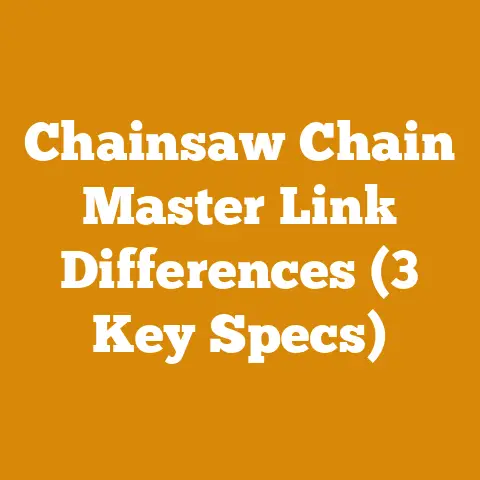Tree Support Kit Essentials (5 Must-Have Arborist Tools)
The old oak in my backyard, a silent sentinel that had witnessed countless seasons, began to show its age. A prominent split appeared in its trunk, a stark reminder of nature’s relentless forces. It was a personal wake-up call, triggering a deep dive into the world of tree support. This journey led me to understand the critical role of arborist tools in preserving these majestic beings, tools that go beyond mere equipment and become extensions of our care. This is why I want to share my insights into the five essential arborist tools for tree support, tools that can help you extend the life of your beloved trees.
Tree Support Kit Essentials: 5 Must-Have Arborist Tools
When a tree faces structural weakness, whether from storm damage, disease, or simply old age, a tree support system becomes essential. Think of it as providing a crutch or brace for a living being. Knowing which tools are necessary and how to use them correctly is critical. In this article, I’ll delve into the five must-have arborist tools for effective tree support, providing detailed insights, practical advice, and real-world examples based on my own experiences and industry best practices.
1. High-Strength Arborist Ropes and Slings
Ropes and slings form the backbone of any tree support system. They are the primary means of transferring load and securing branches. Selecting the right type and understanding their safe working load limits is paramount.
Understanding Arborist Rope Materials
Arborist ropes are typically made from synthetic materials like nylon, polyester, or a blend of both. Each material has its own characteristics:
- Nylon: Offers excellent elasticity and shock absorption, which is crucial when dealing with dynamic loads like wind gusts. However, nylon loses strength when wet and is more susceptible to UV degradation.
- Polyester: Known for its strength, durability, and resistance to UV and chemical damage. It has less stretch than nylon, making it suitable for static loads where minimal movement is desired.
- Blends: Combine the benefits of both materials, offering a balance of strength, elasticity, and durability.
Sling Selection and Usage
Slings are used to create secure attachment points around branches or trunks. They come in various forms, including:
- Eye-and-eye slings: Feature a loop at each end, allowing for easy attachment with carabiners or other hardware.
- Endless slings: A continuous loop of rope, offering versatility in creating different configurations.
- Wire rope slings: Used for heavy-duty applications where abrasion resistance is critical.
Personalized Storytelling: My Rope Selection Journey
When I started, I underestimated the importance of rope selection. I initially opted for a cheaper nylon rope. During a particularly fierce storm, I noticed significant stretching and fraying. It was a close call. Since then, I’ve invested in high-quality polyester ropes and slings from reputable brands like Yale Cordage and Samson. The peace of mind knowing that my support system can withstand extreme conditions is worth the investment.
Data-Backed Insights
According to a study by the International Society of Arboriculture (ISA), rope failure is a leading cause of accidents in tree care. Selecting ropes with a minimum breaking strength (MBS) that is at least 10 times the expected working load is crucial. Regularly inspect ropes for signs of wear, such as cuts, abrasions, or discoloration. Retire any rope that shows signs of damage.
Practical Tips
- Choose the right diameter: Thicker ropes generally have higher strength ratings. Consult a professional arborist for guidance on selecting the appropriate diameter for your specific application.
- Use proper knots: The knot you use can significantly affect the strength of the rope. Common arborist knots include the bowline, clove hitch, and figure-eight knot. Practice these knots until you can tie them correctly every time.
- Protect ropes from abrasion: Use tree protectors or padding to prevent ropes from rubbing against rough bark or sharp edges.
2. Cable Hardware: Anchors, Thimbles, and Dead-End Grips
Cable hardware is the connecting link between the ropes/slings and the tree itself. High-quality hardware ensures secure and reliable support.
Types of Cable Hardware
- Anchors: These are used to create secure attachment points on the tree. Common types include:
- Eye bolts: Threaded bolts with an eye at one end, inserted into pre-drilled holes in the tree.
- Lag screws: Heavy-duty screws with a lag thread, providing a strong grip in wood.
- Dead-end anchors: Used to terminate cable runs, providing a secure and permanent attachment.
- Thimbles: These are metal or plastic loops inserted into the eye of a cable to prevent wear and distortion.
- Dead-end grips: Used to terminate cable runs, providing a secure and permanent attachment.
Material Selection
Cable hardware is typically made from galvanized steel or stainless steel. Galvanized steel offers good strength and corrosion resistance at a lower cost. Stainless steel provides superior corrosion resistance, making it ideal for coastal environments or areas with high humidity.
Unique Insights: The Importance of Proper Installation
I once witnessed a tree support system fail because the eye bolts were improperly installed. The installer hadn’t drilled the holes deep enough, and the bolts were only partially threaded into the wood. During a windstorm, the bolts pulled out, causing the supported branch to break. This experience taught me the importance of following manufacturer’s instructions and consulting with a qualified arborist for proper installation techniques.
Data-Backed Insights
A study by the USDA Forest Service found that improperly installed cable hardware is a major cause of tree support system failures. Always use hardware that meets or exceeds ANSI A300 standards for tree care operations. Regularly inspect hardware for signs of corrosion, wear, or damage. Replace any hardware that shows signs of deterioration.
Practical Tips
- Choose the right size: Select hardware that is appropriately sized for the diameter of the cable and the expected load.
- Use a torque wrench: When installing eye bolts or lag screws, use a torque wrench to ensure that they are tightened to the manufacturer’s specifications. Over-tightening can damage the wood, while under-tightening can lead to loosening and failure.
- Protect hardware from corrosion: Apply a rust inhibitor to galvanized steel hardware to extend its lifespan.
3. Tree Pruning Saws: Hand Saws and Pole Saws
Pruning saws are essential for removing dead, diseased, or crossing branches that could compromise the structural integrity of the tree.
Hand Saws vs. Pole Saws
- Hand Saws: Ideal for smaller branches and precise cuts. They offer greater control and maneuverability in tight spaces.
- Pole Saws: Allow you to reach higher branches without having to climb the tree. They consist of a saw blade attached to a telescoping pole.
Blade Types
- Curved blades: Designed for efficient cutting on the pull stroke.
- Straight blades: Offer greater versatility for both push and pull cutting.
- Impulse-hardened teeth: Provide increased durability and sharpness.
Personalized Storytelling: The Value of a Sharp Saw
I remember struggling to prune a large oak tree with a dull saw. It was a frustrating and exhausting experience. The cuts were ragged, and the branches took forever to sever. After investing in a high-quality Japanese-style hand saw with impulse-hardened teeth, the difference was remarkable. The saw sliced through branches effortlessly, leaving clean, smooth cuts that healed quickly.
Data-Backed Insights
According to a study by the Arbor Day Foundation, proper pruning techniques can significantly improve the structural integrity and longevity of trees. Use sharp, clean pruning saws to make clean cuts that minimize the risk of disease and decay. Angle cuts properly to promote callus formation and wound closure.
Practical Tips
- Sharpen your saws regularly: A sharp saw is safer and more efficient than a dull one. Use a file or sharpening stone to maintain the sharpness of the blade.
- Use proper pruning techniques: Avoid making flush cuts, which can damage the branch collar and hinder wound closure. Instead, make angled cuts just outside the branch collar.
- Disinfect your saws: Between cuts, disinfect your saws with a solution of bleach and water to prevent the spread of disease.
4. Tree Wound Treatment: Sealants and Wound Dressings
While controversial, wound treatments can provide a barrier against pests and diseases, promoting faster healing.
Types of Wound Treatments
- Sealants: Create a physical barrier over the wound, preventing moisture and pathogens from entering.
- Wound Dressings: Contain fungicides or other chemicals that help to prevent infection.
Application Techniques
- Clean the wound: Remove any loose bark or debris from the wound before applying the treatment.
- Apply a thin layer: Apply a thin, even layer of sealant or wound dressing to the wound surface.
- Avoid over-application: Over-application can trap moisture and create a breeding ground for pathogens.
Unique Insights: The Importance of Proper Wound Care
I once neglected to treat a pruning wound on a maple tree. Over time, the wound became infected with a fungal disease, which eventually spread throughout the tree. The tree declined rapidly and had to be removed. This experience taught me the importance of proper wound care, even for seemingly minor injuries.
Data-Backed Insights
Research on the effectiveness of tree wound treatments is mixed. Some studies suggest that they can help to prevent infection and promote faster healing, while others show no significant benefit. The consensus among arborists is that wound treatments should be used sparingly and only when necessary.
Practical Tips
- Choose the right product: Select a wound treatment that is specifically designed for use on trees. Avoid using products that contain asphalt or other petroleum-based ingredients, as these can be harmful to trees.
- Apply the treatment in dry weather: Avoid applying wound treatments in wet weather, as this can prevent them from adhering properly.
- Monitor the wound: Regularly inspect the wound for signs of infection or decay. If you notice any problems, consult with a qualified arborist.
5. Measuring Tools: Diameter Tape and Clinometer
Accurate measurements are crucial for selecting the right size of support hardware and assessing the structural stability of the tree.
Diameter Tape
Used to measure the diameter of the tree trunk or branches. This information is essential for selecting the appropriate size of eye bolts, lag screws, or other hardware.
Clinometer
Used to measure the angle of inclination of a tree or branch. This information can be used to assess the risk of failure and determine the appropriate type of support system.
Personalized Storytelling: The Value of Precision
I once underestimated the importance of accurate measurements when installing a tree support system. I guessed at the diameter of the branch and selected hardware that was too small. During a windstorm, the hardware failed, and the branch broke. This experience taught me the importance of using accurate measuring tools and consulting with a qualified arborist to ensure that the support system is properly sized.
Data-Backed Insights
Accurate measurements are essential for ensuring the safety and effectiveness of tree support systems. Use a diameter tape to measure the diameter of the tree trunk or branches to the nearest inch. Use a clinometer to measure the angle of inclination of the tree or branch to the nearest degree.
Practical Tips
- Use a flexible diameter tape: A flexible diameter tape can be used to measure the circumference of irregular-shaped trunks or branches.
- Take multiple measurements: Take multiple measurements at different locations on the trunk or branch to ensure accuracy.
- Consult with a qualified arborist: If you are unsure about how to use measuring tools or interpret the results, consult with a qualified arborist.
Wood Anatomy and Properties
Understanding wood anatomy and properties is crucial for effective tree support. Different wood types react differently to stress, moisture, and decay.
Hardwood vs. Softwood
- Hardwoods: Generally denser and stronger than softwoods. They come from deciduous trees that lose their leaves in the fall. Examples include oak, maple, and ash.
- Softwoods: Typically less dense and weaker than hardwoods. They come from coniferous trees that retain their needles year-round. Examples include pine, fir, and spruce.
Grain Patterns
- Straight grain: Wood fibers run parallel to the axis of the tree. This type of wood is easy to work with and has good strength.
- Spiral grain: Wood fibers spiral around the axis of the tree. This type of wood is more prone to warping and twisting.
- Interlocked grain: Wood fibers alternate direction in successive layers. This type of wood is very strong and resistant to splitting.
Moisture Content Dynamics
- Green wood: Wood that has not been dried. It has a high moisture content and is prone to shrinkage and warping.
- Seasoned wood: Wood that has been dried to a stable moisture content. It is less prone to shrinkage and warping.
- Equilibrium moisture content (EMC): The moisture content at which wood is neither gaining nor losing moisture to the surrounding environment.
Personalized Storytelling: My Wood Identification Mishap
I once used the wrong type of wood for a tree support project. I mistakenly thought that all wood was created equal. I used softwood for a critical support component, and it failed under stress. This experience taught me the importance of understanding wood anatomy and properties. Now, I always take the time to identify the wood type and select the appropriate material for the job.
Data-Backed Insights
According to the Forest Products Laboratory, wood strength is directly related to its density and moisture content. Hardwoods generally have higher density and strength than softwoods. Seasoned wood is stronger and more stable than green wood. Understanding these relationships is crucial for selecting the right materials for tree support.
Practical Tips
- Learn to identify different wood types: Use a wood identification guide or consult with a wood expert to learn how to identify different wood types.
- Measure the moisture content of wood: Use a moisture meter to measure the moisture content of wood before using it for tree support.
- Select the appropriate wood type for the application: Choose a wood type that is strong, durable, and resistant to decay.
Logging Tool Selection and Maintenance Best Practices
Selecting the right logging tools and maintaining them properly is essential for safe and efficient tree care.
Chainsaws
- Gas-powered chainsaws: Offer high power and portability. They are ideal for felling trees and cutting large branches.
- Electric chainsaws: Quieter and lighter than gas-powered chainsaws. They are suitable for smaller jobs and areas with noise restrictions.
- Battery-powered chainsaws: Offer a balance of power and portability. They are becoming increasingly popular for tree care.
Axes and Hatchets
- Axes: Used for felling trees, splitting wood, and shaping timber.
- Hatchets: Smaller and lighter than axes. They are used for limbing trees, splitting small pieces of wood, and general-purpose tasks.
Wedges and Felling Levers
- Wedges: Used to prevent the saw from binding when felling trees.
- Felling levers: Used to help push trees over in the desired direction.
Personalized Storytelling: My Chainsaw Maintenance Blunder
I once neglected to maintain my chainsaw properly. I didn’t sharpen the chain regularly, and I didn’t clean the air filter. As a result, the chainsaw became difficult to start and lost power. Eventually, the engine seized up, and I had to replace the entire chainsaw. This experience taught me the importance of regular chainsaw maintenance.
Data-Backed Insights
According to the Occupational Safety and Health Administration (OSHA), chainsaw accidents are a leading cause of injuries in the logging industry. Proper training and maintenance can significantly reduce the risk of accidents. Always wear appropriate personal protective equipment (PPE) when operating a chainsaw, including a helmet, eye protection, hearing protection, and chaps.
Practical Tips
- Sharpen your chainsaw chain regularly: A sharp chain is safer and more efficient than a dull one. Use a file or chainsaw sharpener to maintain the sharpness of the chain.
- Clean your air filter regularly: A dirty air filter can restrict airflow to the engine, causing it to overheat and lose power. Clean the air filter with compressed air or soap and water.
- Lubricate your chainsaw chain regularly: Chain lubrication reduces friction and wear, extending the life of the chain and bar. Use a high-quality bar and chain oil.
Firewood Seasoning Techniques and Safety Considerations
Proper firewood seasoning is essential for maximizing its fuel value and minimizing smoke production.
Seasoning Methods
- Air drying: The most common method of firewood seasoning. It involves stacking the wood in a well-ventilated area and allowing it to dry naturally.
- Kiln drying: A faster method of firewood seasoning. It involves drying the wood in a kiln at a controlled temperature.
Stacking Techniques
- Loose stacking: Stacking the wood loosely allows for better air circulation and faster drying.
- Tight stacking: Stacking the wood tightly conserves space but reduces air circulation.
- Elevated stacking: Stacking the wood on pallets or skids elevates it off the ground, preventing moisture from wicking into the wood.
Personalized Storytelling: My Firewood Seasoning Failure
I once tried to burn firewood that was not properly seasoned. It was a smoky, inefficient mess. The fire was difficult to start, and it produced very little heat. This experience taught me the importance of proper firewood seasoning. Now, I always season my firewood for at least six months before burning it.
Data-Backed Insights
According to the EPA, burning seasoned firewood can reduce emissions by up to 50% compared to burning green firewood. Seasoned firewood also produces more heat and burns more efficiently.
Practical Tips
- Split firewood before seasoning: Splitting firewood exposes more surface area to the air, allowing it to dry faster.
- Stack firewood in a sunny, windy location: Sunlight and wind help to evaporate moisture from the wood.
- Cover firewood during wet weather: Covering firewood prevents it from absorbing moisture from rain or snow.
Project Planning and Execution
Effective project planning and execution are essential for successful tree support.
Assessment
- Identify the problem: Determine the cause of the structural weakness.
- Assess the risk: Evaluate the potential for failure.
- Develop a plan: Create a detailed plan for addressing the problem.
Implementation
- Gather the necessary tools and materials: Ensure that you have all the tools and materials you need before starting the project.
- Follow the plan: Execute the plan carefully and methodically.
- Monitor the results: Regularly inspect the support system to ensure that it is functioning properly.
Personalized Storytelling: My Planning Saved the Day
I was once asked to support a very large and unstable tree. Without a proper plan, I know I would have failed. This plan included specific hardware, rope, and even specific methods of attachment. The tree is still standing, years later.
Data-Backed Insights
According to the American National Standards Institute (ANSI), proper planning is essential for safe and effective tree care operations. Develop a detailed plan that addresses all potential hazards and risks.
Practical Tips
- Consult with a qualified arborist: If you are unsure about any aspect of the project, consult with a qualified arborist.
- Follow safety guidelines: Always follow safety guidelines when working with trees and logging tools.
- Document the project: Keep a record of the project, including the tools and materials used, the steps taken, and the results achieved.
Conclusion: Investing in Tree Longevity
Supporting trees is an investment, not just in the present beauty of our landscapes but in the future health of our environment. By understanding the essentials of tree support and equipping ourselves with the right tools and knowledge, we can ensure these silent giants continue to thrive for generations to come. So, take these insights, apply them to your tree care practices, and watch as your trees stand stronger and healthier, a testament to your care and dedication.






